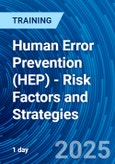Product Human Error Assessment and Reduction Technique (HEART), is a technique used in the field of Human Reliability Assessment (HRA), for the purposes of evaluating the probability of a human error occurring throughout the completion of a specific task, Also called Human Error Prevention (HEP). Used to enhance risk and human factors analysis with the goal of product use error reduction.
Device Risk Analysis/Management, and Use / Human Factors Engineering and related software and hardware design, development, verification and validation is difficult to manage, document and control. This presentation focuses on the use of HEP, HRA and HEART tools to add additional review areas to Risk Management and Human Factors Analysis to effect beneficial and safer design development and changes under Design Control in primarily the R&D environment, for new products and major changes to existing product.
Why Should You Attend
Product Human Error Assessment and Reduction Technique (HEART), used by NASA, is a technique used in the field of Human Reliability Assessment (HRA), for the purposes of evaluating the probability of a human error occurring throughout the completion of a specific task, and with the end result of Human Error Prevention (HEP; Use/Usability Engineering).
Measures can then be taken to reduce the likelihood of errors occurring within a system and therefore lead to improvement in safety. Used in conjunction with Device Risk Management and Use / Human Factors Engineering in device Design Control among other activities.
There exist three primary reasons for conducting an HRA:
1) Error identification
2) Error quantification
3) Error reduction.
There can be a number of techniques used, split into one of two classifications: first-generation techniques, and second generation techniques. First generation techniques work on the basis of the simple dichotomy of 'fits/doesn't fit' in the matching of the error situation in context with related error identification and quantification. Second generation techniques are more theory based in their assessment and quantification of errors.
Course Content
- HEP Considerations
- HRA Considerations
- HEART and Complementary Tools
- Use of HEP, et al, in Risk and Use Engineering
- Expected Regulatory Deliverables
Course Provider

John E Lincoln,
Principal ,
J. E. Lincoln and Associates LLCJohn E. Lincoln is Principal of J. E. Lincoln and Associates LLC, a consulting company, with over 32 years experience in U.S. FDA-regulated industries, 18 of which as a full time independent FDA-regulated industry consultant. Mr. Lincoln has worked with companies from start-up to Fortune 100, in the U.S., Mexico, Canada, France, Germany, Sweden, China and Taiwan. He specializes in quality assurance, regulatory affairs, QMS / CGMP audits and problem remediation and FDA responses, new / changed product 510(k)s, process / product / equipment including QMS and software validations, ISO 14971 product risk management files / reports, Design Control / Design History Files, Technical Files. He’s held positions in Manufacturing Engineering, QA, QAE, Regulatory Affairs, to the level of Director and VP (R&D).
In addition, he has prior experience in military, government, electronics, and aerospace. He has published numerous articles in peer reviewed journals, conducted workshops and webinars worldwide on CAPA, 510(k)s, risk analysis / management, FDA / GMP audits, validation, root cause analysis, and others. He is a graduate of UCLA.
Who Should Attend
This webinar will provide valuable assistance to all regulated companies in evaluating their R&D, Product Development and Major Product Changes with the focus on medical devices. It will help attendees understand and recognize the most common Design Control failings and their fixes, using HEP consideration in Risk and Human Factors considerations and implementation. This information applies to personnel/companies in the Medical Device, Diagnostic, and combination products fields. The employees who will benefit include:
- Senior management
- Regulatory Affairs
- Quality Assurance / QAE
- Production
- Engineering, R&D, and product development and testing teams
All personnel involved in a U.S. FDA-regulated environment. Especially those involved in new product development quality management systems looking for some novel approaches to existing risk and use error resolution.









